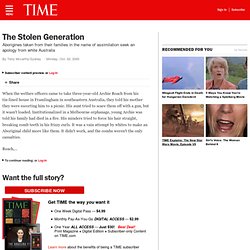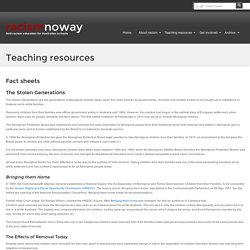

The Stolen Generation. When the welfare officers came to take three-year-old Archie Roach from his tin-lined house in Framlingham in southeastern Australia, they told his mother they were escorting him to a picnic.

His aunt tried to scare them off with a gun, but it wasn't loaded. Institutionalized in a Melbourne orphanage, young Archie was told his family had died in a fire. His minders tried to force his hair straight, breaking comb teeth in his frizzy curls. It was a vain attempt by whites to make an Aboriginal child more like them. It didn't work, and the combs weren't the only casualties. Roach,... Subscribe Now Get TIME the way you want it One Week Digital Pass — $4.99 Monthly Pay-As-You-Go DIGITAL ACCESS — $2.99 One Year ALL ACCESS — Just $30!
Bringing them home: The 'Stolen Children' report (1997) The Stolen Generations. A guide to Australia’s Stolen Generations. Detail of the ‘Great Australian Clock’, Queen Victoria Building, Sydney.

Note that the artist confined Aboriginal men to the painted background, seemingly ignorant of the situation. You can view the clock from the highest level inside the building. One of the darkest chapters of Australian history was the forced removal of Aboriginal children from their families. Children as young as babies were stolen from their families to be placed in girls and boys homes, foster families or missions. At the age of 18 they were ‘released’ into white society, most scarred for life by their experiences. These Aboriginal people are collectively referred to as the ‘Stolen Generations’ because several generations were affected.
Many Aboriginal people are still searching for their parents and siblings. I feel our childhood has been taken away from us and it has left a big hole in our lives. Racism. No Way.: Fact Sheets: The Stolen Generations. Fact sheets The Stolen Generations The 'Stolen Generations' are the generations of Aboriginal children taken away from their families by governments, churches and welfare bodies to be brought up in institutions or fostered out to white families.

Removing children from their families was official government policy in Australia until 1969. However, the practice had begun in the earliest days of European settlement, when children were used as guides, servants and farm labour. National Library Title : Broken Circles fragmenting families, National Library Title: The Stolen Generations (videorecording) National Library Title : Rabbit Proof-fence (videorecording : DVD) National Library Book Title: Bringing them home : report of the.
National Library Title : Many Voices : reflections on experiences. Introduction to The Stolen Generation. Sorry Day and the Stolen Generations. Warning.

This article may contain the names and images of Aboriginal and Islander people now deceased. It also contains links to sites that may use images of Aboriginal and Islander people now deceased. Human Rights and Equal Opportunity Commission, report. Stolen generation. The Stolen Children. An extract from Carmel Bird's introduction to: The Stolen Children -- Their Stories Carmel Bird © all rights reserved Marked by a cross drawn in ink at about the place where her navel would be, the child stands in the centre of the group of six tiny girls.
Her companions look shyly, sadly, at the camera; but her eyes are downcast. She seems to be oblivious, or at least forgetful, of the photographer, concentrating on a ball that she cradles at shoulder level. This child, with her high-domed forehead and gently pouting upper lip, is an orphan among orphans, Australian children of mixed race. Timeline: Stolen Generations. The Stolen Generations’ Testimonies. Stolen-generations-postcard-1. » Stolen Generations Fact Sheet. Behind the statistics and official terminology. For the past 25 years, academic historians have subjected the officials of the Aborigines Protection Board to a ferocious barrage of criticism. Unfortunately, the latter are all long dead and unable to respond. In order to address their critics, and do some justice to their reputations, let me elaborate some of the reasons they gave and the cases they responded to.
What follows are a number of individual examples from the most commonly given reasons for the separation of Aboriginal children from their families from 1907 to 1932. They flesh out the meaning behind the categories used in Tables 2.5 and 2.6 Neglected: In some cases, the local representatives of the board, such as a station manager, policeman or reserve matron, made a decision that a child was neglected. Mother died, father neglected the children. Living under conditions likely to result in minimal life. NT Stolen Generation Aboriginal Community - Northern Territory Stolen Generations Aboriginal Corporation. Stolen Generations. A portrayal entitled The Taking of the Children on the 1999 Great Australian Clock, Queen Victoria Building, Sydney, by artist Chris Cook.

Documentary evidence, such as newspaper articles and reports to parliamentary committees, suggest a range of rationales. Motivations evident include child protection, beliefs that given their catastrophic population decline after white contact that Aboriginal people would die out,[7] and a fear of miscegenation by full-blooded Aboriginal people.[8] Emergence of the child removal policy[edit] Other 19th- and early 20th-century contemporaneous documents[citation needed] indicate that the policy of removing Aboriginal children from their parents related to different beliefs: that given the catastrophic population decline of Aboriginal people after white contact that they would die out, that the full-blood tribal Aboriginal population would be unable to sustain itself, and was doomed to inevitable extinction.[12][13][14]